WOC 531
Page 531
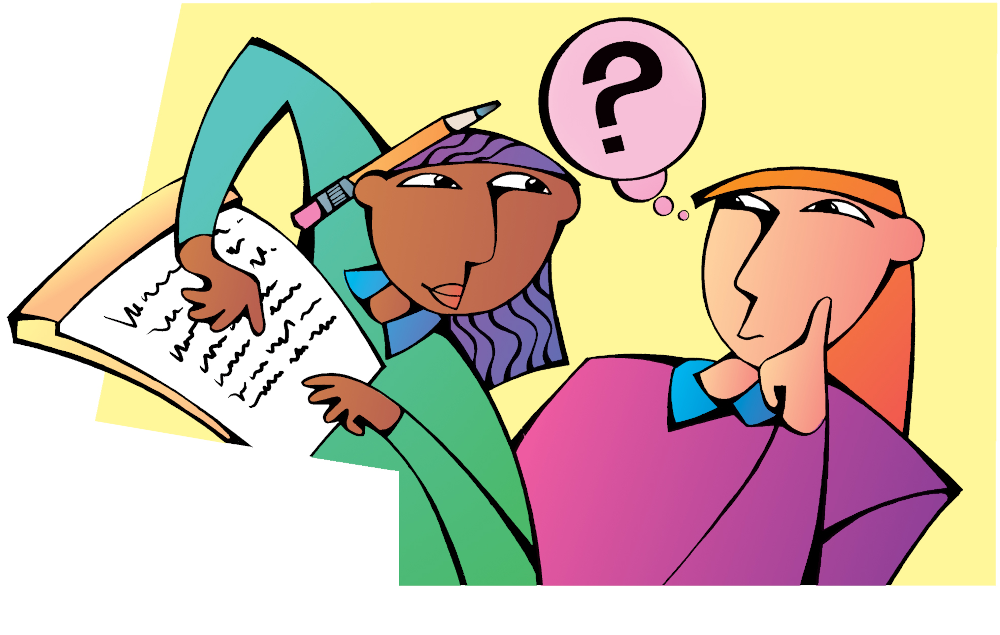
Understanding Our Language
Noun
Kinds of Nouns
A noun is a word that names something: a person, a place, a thing, or an idea.
Roger Whitson (uncle) “Star-Spangled Banner” (song) Mississippi (river) Labor Day (holiday)
531.1 Proper Noun
A proper noun is the name of a specific person, place, thing, or idea. Proper nouns are capitalized.
Jordan Love, Chicago Aquarium, Star Wars, Buddhism
531.2 Common Noun
A common noun names a nonspecific person, place, thing, or idea. Common nouns are not capitalized.
man, museum, movie, religion
531.3 Concrete Noun
A concrete noun names a thing that is physical (can be touched or seen). Concrete nouns can be either common or proper.
pizza, podcast, Mount Everest
531.4 Abstract Noun
An abstract noun names something you can think about but can’t see or touch. Abstract nouns can be either common or proper.
Christianity, Judaism, poverty, wealth, conservation, belief
531.5 Collective Noun
A collective noun names a group or collection of persons, animals, or things.
Persons: tribe, congregation, family, class, team
Animals: flock, herd, gaggle, clutch, litter
Things: batch, cluster, bunch, collection
WOC 532
Page 532
Number of Nouns
Nouns are classified according to their number. The number of a noun tells us whether the noun is singular or plural.
532.1 Singular Noun
A singular noun names one person, place, thing, or idea.
boy, group, audience, stage, concert, hope
532.2 Plural Noun
A plural noun names more than one person, place, thing, or idea.
boys, groups, audiences, stages, concerts, hopes
For information on how to create the plural form of nouns, turn to pages 500–501.
532.3 Compound Noun
A compound noun is made up of two or more words.
football (written as one word)
middle school (written as two words)
brother-in-law (written as a hyphenated word)
Gender of Nouns
Nouns have gender, which means they can be grouped according to sex: feminine, masculine, neuter, and indefinite.
532.4 Gender
Feminine: mother, sister, women, cow, hen (female)
Masculine: father, brother, men, bull, rooster (male)
Neuter: tree, cobweb, closet (without gender)
Indefinite: president, doctor (undefined gender)
Turn to page 347 for more information on using gender properly when writing.
Uses of Nouns
Nouns are classified according to their use in a sentence.
532.5 Subject Nouns
A subject noun is a noun used as the subject of a sentence. As such, it is either doing something or being talked about.
The young girl reached out to touch the salamander. Its skin was smooth and wet.
(The subject girl is “doing something,” and the subject skin is “being talked about.”)
WOC 533
Page 533
533.1 Predicate Nouns
A noun becomes a predicate noun when it follows a be verb (is, are, was, were, been) and repeats or renames the subject.
Salamanders are amphibians. These animals are water-dwellers.
(In these sentences, amphibians renames salamanders, and water-dwellers renames animals.)
533.2 Possessive Nouns
A noun becomes a possessive noun when it shows possession or ownership.
A wetland’s population of amphibians is an insect’s worst nightmare.
Turn to 494.5–495.4 for more about possessive nouns.
533.3 Object Nouns
A noun becomes an object noun when it is used as the direct object, the indirect object, or the object of the preposition.
In the wild, a salamander eats worms, insects, and slugs.
(Worms, insects, and slugs are direct objects.)
I feed my pet salamander crickets from a special box.
(Salamander is an indirect object, crickets is a direct object, and box is an object of the preposition from.)
Pronoun
A pronoun is a word used in place of a noun. Pronouns are used to avoid needless repetition in your writing.
her, it, which, they, who, themselves, this
533.4 Antecedent
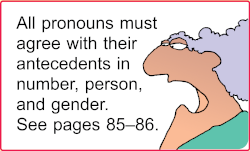
An antecedent is the noun that the pronoun refers to or replaces. Almost all pronouns have antecedents.
The friends used binoculars to search the night sky for the International Space Station. They knew it was passing over their city and would look like a fast-moving star.
(Friends is the antecedent of they and their; International Space Station is the antecedent of it.)
WOC 534
Page 534
534.1 Personal Pronouns
These are the basic personal pronouns.
I, you, he, she, it, we, they
These are some of the other forms of pronouns.
me, him, her, us, them, mine, yours, ourselves, their, its
Number of Pronouns
534.2 Singular/Plural
Pronouns can be either singular or plural in number.
Singular: I, you, he, she, it
Plural: we, you, they
Note: You, your, and yours may be singular or plural.
Person of a Pronoun
The person of a pronoun tells us whether the pronoun is speaking, being spoken to, or being spoken about.
534.3 First Person
A first-person pronoun is used in place of the speaker.
I think I can see the International Space Station.
534.4
A second-person pronoun names the person or thing spoken to.
Jayden, can you spot the space station?
534.5 Third Person
A third-person pronoun names the person or thing spoken about.
NASA uses its website to share information about the space station.
Uses of Pronouns
A pronoun can be used as a subject or an object or to show possession.
534.6 Subject Pronouns
A subject pronoun is used as the subject of a sentence (I, you, he, she, it, we, they).
You can even ask one of the crew members questions.
A subject pronoun is also used after a form of the be verb (am, is, are, was, were, being, been) if it repeats the subject.
It is she who can tell you what living on the space station is like.
WOC 535
Page 535
535.1 Object Pronouns
An object pronoun can be used as the object of a verb or preposition (me, you, him, her, it, us, them).
The stars fascinate us.
(Us is the direct object of the verb fascinate because it receives the action of the verb.)
Mr. Short gave me a book about space travel.
(Me is the indirect object of the verb gave because it indirectly receives the action of the verb.)
Does being a astronaut appeal to you?
(You is the object of the preposition to.)
535.2 Possessive Pronouns
A possessive pronoun shows possession or ownership.
my, mine, our, ours, your, yours, his, her, hers, their, theirs, its
Note: Do not use an apostrophe with a personal pronoun to show possession.
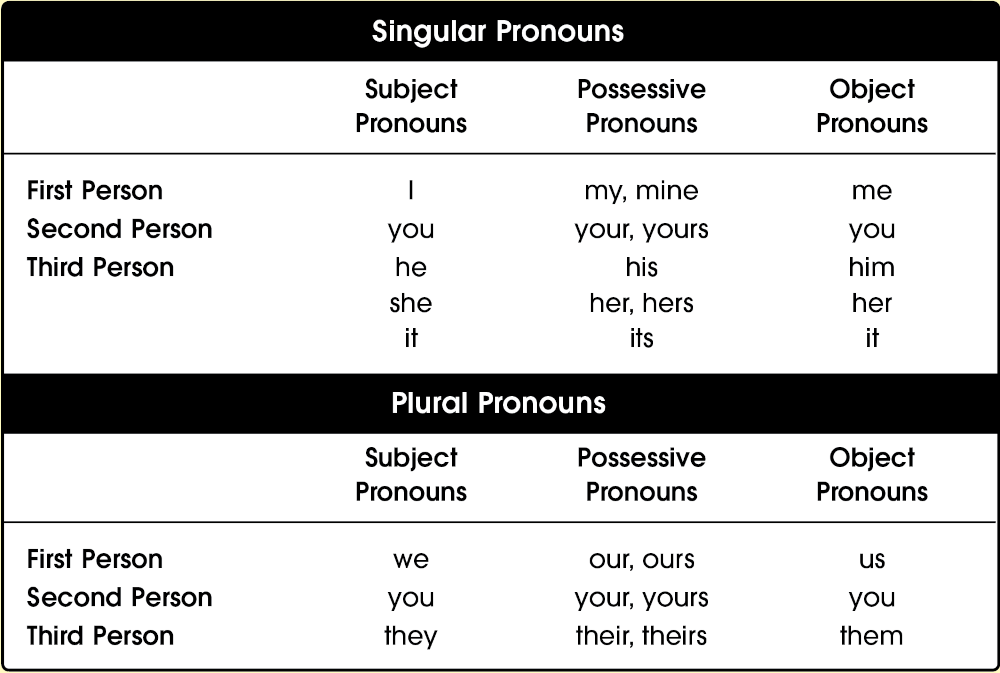
Note: My, your, her, his, our, its, and their come before nouns and function as adjectives.
Our hamsters escaped.
The possessive pronouns hers, ours, yours, theirs, and mine do not come before nouns.
This one is mine. Yours is behind the couch.
WOC 536
Page 536
Other Types of Pronouns
In addition to the commonly used personal pronouns, there are a number of other types of pronouns that you should know about. (See the chart on the next page.)
536.1 Relative Pronouns
A relative pronoun is both a pronoun and a connecting word. It connects a subordinate clause to the main clause.
China, which has the largest population in the world, is home to about 1.4 billion people.
(Which relates to China.)
The Chinese, who have worked hard to modernize their country, hosted the 2022 Winter Olympics.
(Who relates to Chinese.)
Beijing, which hosted the Games in 2008, is the first city to host both Summer and Winter Olympics.
(Which relates to Beijing.)
Who? Which? That? If you have trouble figuring out which of these pronouns to use when, turn to 525.3.
536.2 Interrogative Pronouns
An interrogative pronoun asks a question.
We can eat here or go out. Which should we do? Who can cook? What is in the freezer?
I found a ring! Whom should we tell? Whose is it, do you think?
536.3 Demonstrative Pronouns
A demonstrative pronoun points out or identifies a noun without naming the noun.
This is a beautiful park!
Are these the campsites you wanted?
That was a steep climb. Those are closer to the lake.
Caution: Do not add here or there to a demonstrative pronoun. Both of the following examples are incorrect.
This here is a beautiful park!
That there was a steep climb.
536.4 Intensive Pronouns
An intensive pronoun emphasizes or intensifies the noun or pronoun it refers to. Common intensive pronouns include itself, myself, himself, herself, and yourself.
Although Leesa is a strong, capable rock climber, she herself is very aware of the sport’s dangers.
Note: The sentence would be complete without the pronoun herself, which simply emphasizes she.
WOC 537
Page 537
537.1 Reflexive Pronouns
A reflexive pronoun is a pronoun that reflects back upon the subject of a sentence or clause.
Leesa joined a climbing club that prides itself in an excellent safety record.
(direct object of the verb prides)
She gave herself plenty of time to train before doing any rock climbing.
(indirect object)
Climbers are always dreaming up new challenges for themselves.
(object of the preposition)
Note: These sentences would not be complete without the reflexive pronouns.
537.2 Indefinite Pronouns
An indefinite pronoun is a pronoun that does not specifically name its antecedent (the noun or pronoun it replaces).
Will anyone ever visit the stars? Just to reach the nearest one (our own sun excepted), someone would have to travel at the speed of light for 4.2 years.
See page 85 for details on using indefinite pronouns properly in a sentence.
537.3 Kinds of Pronouns
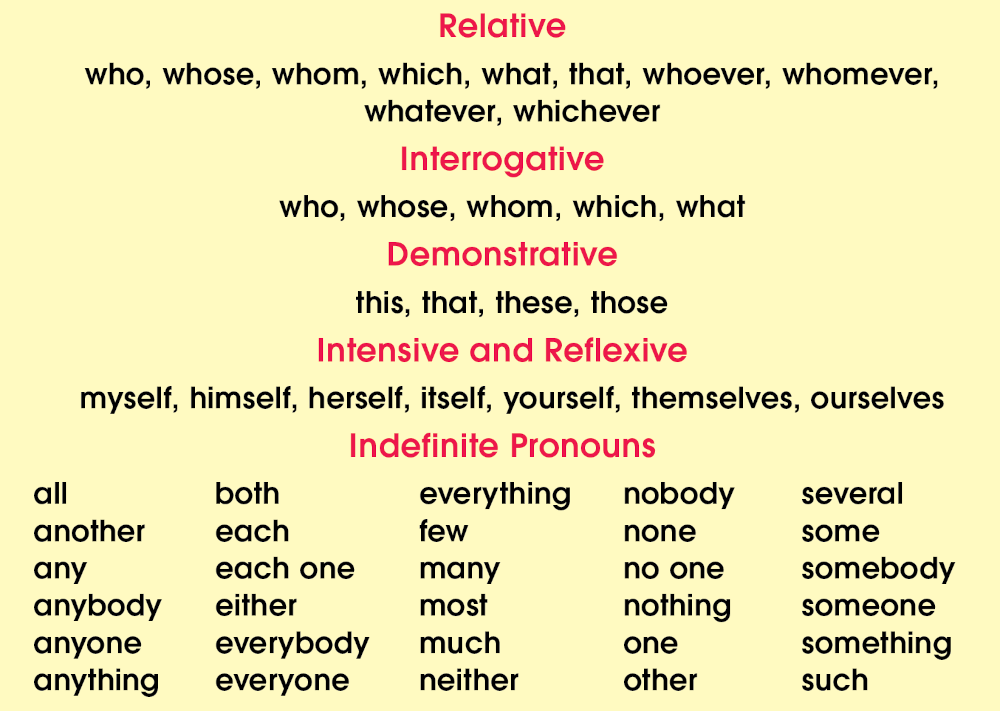
WOC 538
Page 538
Verb
Types of Verbs
A verb is a word that shows action or existence (state of being).
Tornadoes cause tremendous damage. (action)
The weather is often calm before a storm. (existence)
538.1 Action Verb
An action verb tells what the subject is doing.
Natural disasters batter the globe nearly every day.
538.2 Linking Verb
A linking verb connects or links a subject to a noun or an adjective in the predicate.
The 2023 earthquake in Turkey was a true disaster.
(Disaster is a predicate noun linked by the verb was to the subject earthquake.)
I am concerned for the victims of this disaster.
(Concerned is a predicate adjective linked by the verb am to the subject I.)
Linking Verbs
The most common linking verbs are forms of the verb be—is, am, are, was, were, being, been—and verbs such as smell, look, taste, feel, remain, turn, appear, become, sound, seem, grow, stand.
538.3 Helping Verb
Helping verbs help to form some of the tenses and voice of the main verb. (Helping verbs are also called auxiliary verbs.)
Most people do know that shooting stars are not stars, but meteors that are burning while blasting through Earth’s atmosphere.
Helping Verbs
The most common helping verbs are can, could, will, would, shall, should, may, might, must, have, has, had, do, does, did, and the forms of the verb be—is, am, are, was, were, being, been.
WOC 539
Page 539
Number of Verbs
Verbs have number, which means they are singular or plural. The number of a verb depends on the number of its subject.
539.1 Singular/Plural
A singular subject needs a singular verb. A plural subject needs a plural verb.
One wonders about life on other planets. (singular)
We wonder about life on other planets. (plural)
Person of Verbs
539.2 Point of View
Verbs will also differ in form depending upon the point of view, or person, of the pronouns being used with them:
First person
I write. (singular)
We write. (plural)
Second person
You write. (singular)
You write. (plural)
Third person
He/she/it writes. (singular)
They write. (plural)
Voice of Verbs
The voice of a verb tells you whether the subject is doing the action or is receiving the action.
539.3 Active Voice
A verb is in the active voice if the subject is doing the action.
Oceanographers discovered dead zones in the oceans.
539.4 Passive Voice
A verb is in the passive voice if the subject is receiving the action.
Dead zones in the oceans were discovered by oceanographers.
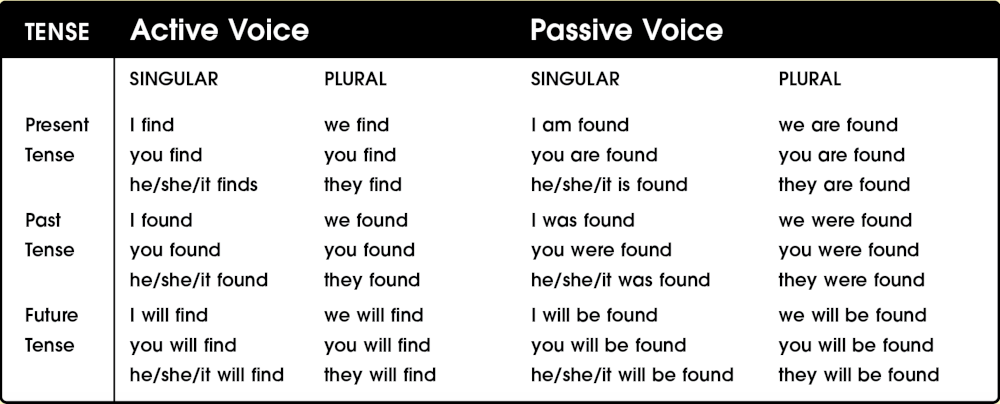
WOC 540
Page 540
Tenses of Verbs
A verb has three principal parts: the present, past, and past participle. All six of the tenses are formed from these principal parts.
The past and past participle of regular verbs are formed by adding -ed
Irregular verbs are formed with different spellings. (See page 541.)
540.1 Present Tense
A verb is in the present tense when it expresses action or existence that is happening now or that happens continually or regularly.
An ocean dead zone is oxygen deprived. No fish live there.
540.2 Past Tense
A verb is in the past tense when it expresses action that is completed at a particular time in the past.
Scientists discovered why these dead zones formed.
540.3 Future Tense
A verb is in the future tense when it expresses action that will take place.
Dead zones will revive if people will follow new practices.
540.4 Present Perfect Tense
A verb is in the present perfect tense when it expresses action that began in the past but continues or is completed in the present.
Some bay communities have been vigilant about sewage treatment.
Note: To form this tense, add has or have to the past participle.
540.5 Past Perfect Tense
A verb is in the past perfect tense when it expresses action that began in the past and was completed in the past.
The bay’s sewage problems had begun in the 1950s.
Note: To form this tense, add had to the past participle.
540.6 Future Perfect Tense
A verb is in the future perfect tense when it expresses action that will begin in the future and will be completed by a specific time in the future.
By 2030, scientists will have known about the Gulf of Mexico’s dead zone for almost 60 years.
Note: To form this tense, add will have to the past participle.
WOC 541
Page 541
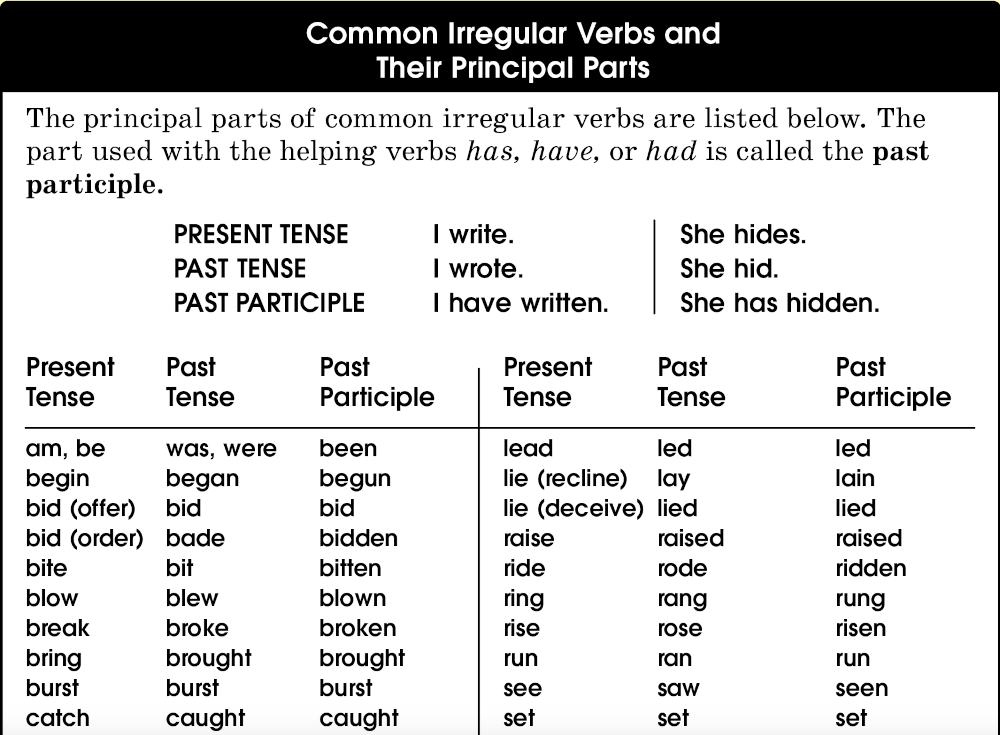
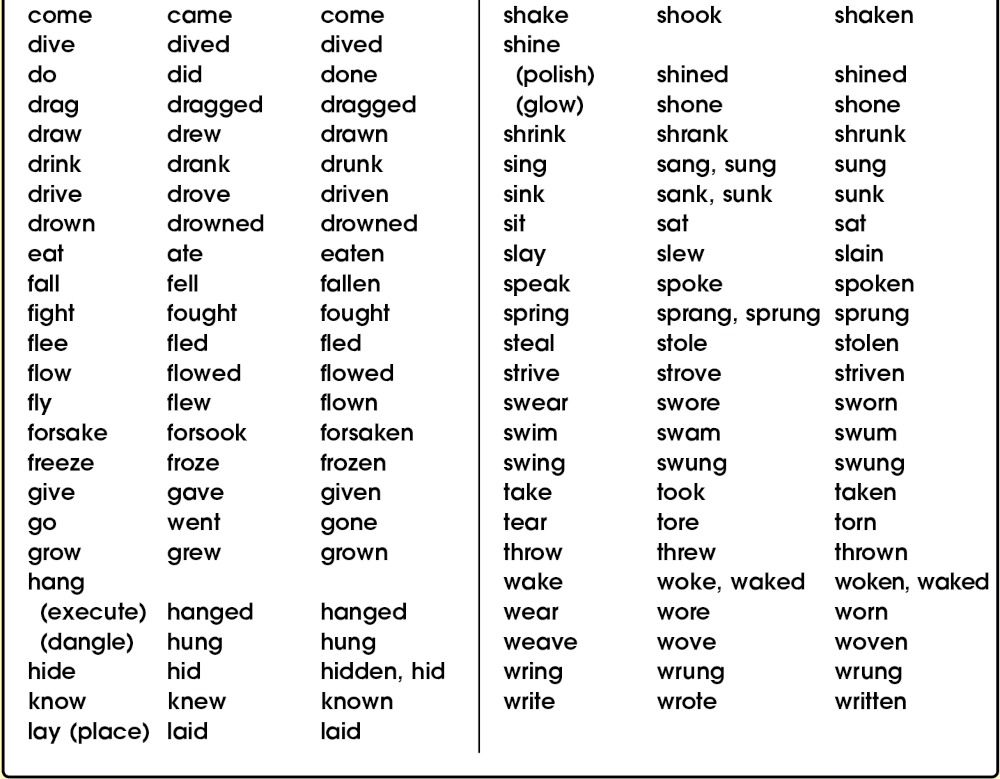
WOC 542
Page 542
Uses of Action Verbs
542.1 Transitive Verbs
Transitive verbs are verbs that transfer their action to an object. An object must receive the action of a transitive verb for the meaning of the verb to be complete.
The earthquake shook San Francisco with a fury.
Shook transfers its action to San Francisco. Without San Francisco, the meaning of the verb shook is incomplete.)
San Francisco was shaken by the earthquake.
(The subject of the sentence, San Francisco, receives the action of the verb, was shaken.)
A transitive verb throws the action directly to a direct object and indirectly to an indirect object. For a sentence to have an indirect object, it must have a direct object. A sentence can, however, have only a direct object.
Note: Direct and indirect objects are always nouns or pronouns.
Fires destroyed San Francisco after the 1906 earthquake.
(direct object: San Francisco)
Our teacher gave us the details.
(indirect object: us; direct object: details)
See 528.1–528.2 for more about direct and indirect objects.
542.2 Intransitive Verbs
An intransitive verb completes its action without an object.
Her stomach felt queasy.
(Queasy is a predicate adjective; there is no direct object.)
She looked for a mint.
(Again, there is no direct object. Mint is the object of the preposition for.)
542.3 Transitive/Intransitive
Some verbs can be either transitive or intransitive.
She read my note. (transitive)
She read aloud. (intransitive)
WOC 543
Page 543
Verbals
A verbal is a word that is made from a verb, has the power of a verb, but acts as another part of speech. Gerunds, participles, and infinitives are verbals.
543.1 Gerund
A gerund is a verb form that ends in -ing and is used as a noun.
Exercising is important.
(The gerund exercising is the subject.)
My grandfather “blames” exercising for his good health.
(The gerund exercising is the direct object.)
543.2 Participle
A participle is a verb form that ends in -ing or -ed and is used as an adjective.
I often see him running, biking, or walking by our house.
(Running, biking, and walking modify him.)
He never looks tired.
(Tired modifies he.)
543.3 Infinitive
An infinitive is a verb form introduced by to; it may be used as a noun, an adjective, or an adverb.
To swim is fun for Grandpa.
(To swim is the subject of this sentence.)
He’s always ready to play with my little brother.
(To play modifies the adjective ready.)
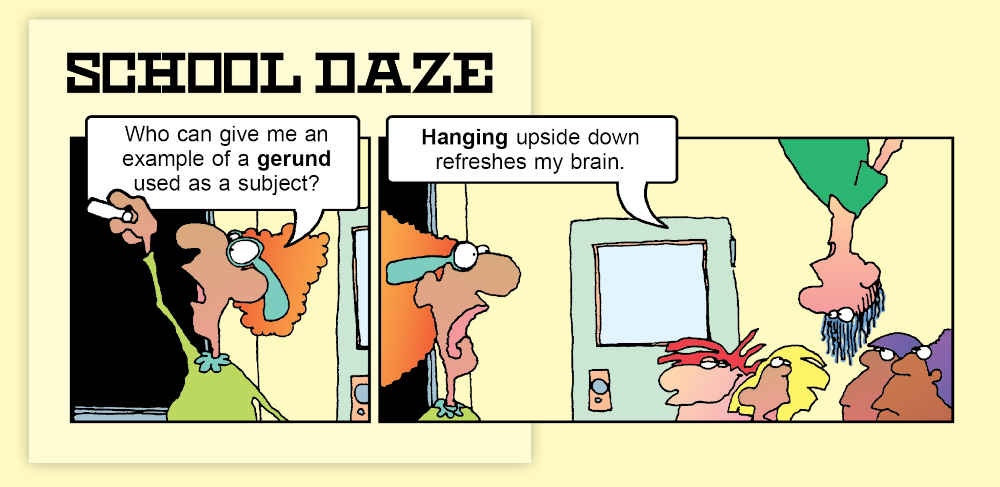
WOC 544
Page 544
Adjective
An adjective is a word used to describe a noun or pronoun.
Why did ancient dinosaurs become extinct?
Were they wiped out by the gigantic asteroid or the impact winter?
544.1 Articles
The articles a, an, and the are adjectives.
the diplodocus, a huge dinosaur, an animal
544.2 Proper Adjective
A proper adjective is formed from a proper noun, and it is always capitalized.
A Chicago museum is home to many dinosaur skeletons.
(Chicago is a proper adjective describing the noun museum.)
544.3 Common Adjective
A common adjective is any adjective that is not proper, and it is not capitalized (unless it is the first word in a sentence).
Ancient mammoths were huge, woolly creatures.
Special Kinds of Adjectives
544.4 Demonstrative Adjective
A demonstrative adjective is one that points out a particular noun. This and these point out something nearby; that and those point out something at a distance.
This mammoth is huge, but that mammoth is even bigger.
Note: When a noun does not follow this, these, that, or those, they are pronouns, not adjectives.
544.5 Compound Adjective
A compound adjective is made up of two or more words. (Sometimes it is hyphenated.)
Scientists have discovered some quick-frozen mammoths.
544.6 Indefinite Adjective
An indefinite adjective does not tell exactly how many or how much. (See 537.2.)
Some mammoths were heavier than today’s elephants.
WOC 545
Page 545
545.1 Predicate Adjective
A predicate adjective follows a linking verb and describes the subject.
Mammoths were once abundant, but now they are extinct.
Forms of Adjectives
545.2 Positive Form
The positive form of an adjective describes a noun or pronoun without comparing it to anyone or anything else.
Bullet trains are fast, traveling at incredible speeds.
545.3 Comparative Form
The comparative form (-er/more/less) compares two persons, places, things, or ideas.
Magnetic levitation (maglev) trains are faster than the bullets, reaching speeds that are even more incredible.
545.4 Superlative Form
The superlative form (-est/most/least) compares three or more persons, places, things, or ideas.
Supersonic jets are the fastest way to travel, cruising at the most incredible speeds of all.
545.5 Two-Syllable Adjective
Some two-syllable adjectives show comparisons by the -er/-est suffixes, or by modifiers more/most and less/least.
clumsy, clumsier, clumsiest (or)
clumsy, more clumsy, most clumsy
clumsy, less clumsy, least clumsy
545.6 Adjective of Three or More Syllables
Adjectives of three or more syllables usually require the words more/most or less/least to express comparison.
ridiculous, less ridiculous, least ridiculous
Note: Do not say “ridiculouser” or “ridiculousest.”
545.7 Irregular Forms
Some adjectives use completely different words to express comparison.
good, better, best
bad, worse, worst
WOC 546
Page 546
Adverb
An adverb is a word used to modify a verb, an adjective, or another adverb. An adverb tells how, when, where, why, how often, and how much.
Dad snores loudly.
(Loudly modifies the verb snores.)
His snores are really explosive.
(Really modifies the adjective explosive.)
Dad snores very loudly.
(Very modifies the adverb loudly.)
546.1 Forms of Adverbs
Adverbs, like adjectives, have three forms: positive, comparative, and superlative. (See the chart below.)
Positive . . . . . . . . describes
Comparative. . . . . . . . compares two things
Superlative. . . . . . . . compares three or more things

546.2 Types of Adverbs
There are four basic types: adverbs of time, place, manner, and degree.
■ Time Adverbs of time tell when, how often, and how long
tomorrow, often, never
■ Place Adverbs of place tell where, to where, or from where.
there, backward, outside
■ Manner Adverbs of manner often end in -ly and tell how something is done.
unkindly, gently, well
■ Degree Adverbs of degree tell how much or how little.
scarcely, completely, almost
Note: Adverbs often end in -ly, but not always, as with often, there, well, quite, and many others. Also note that some words that end in -ly are adjectives, as with lovely or homely.
WOC 547
Page 547
Preposition
A preposition is a word (or group of words) that often shows position or direction and is used to indicate the relationship between two words or ideas. Specifically, a preposition shows how its object is related to some other word in the sentence.
We looked out the window.
(Out shows the relationship between the verb, looked, and the object of the preposition, window.)
547.1 Prepositional Phrase
A prepositional phrase includes the preposition, the object of the preposition, and the modifiers of the object.
Except for a few white clouds, the sky was blue.
(preposition: except for; object: clouds; modifiers: a, few, white)
A prepositional phrase may serve as an adjective or an adverb.
The day was perfect for hiking.
(The prepositional phrase, for hiking, functions as an adverb and modifies perfect.)
547.2 Object of Preposition
A preposition always appears with its object.
We grabbed our backpacks from the table.
If one of the words in 547.3 appears in a sentence alone, the word is probably an adverb.
We headed outside
(Outside is an adverb.)
547.3 Prepositions
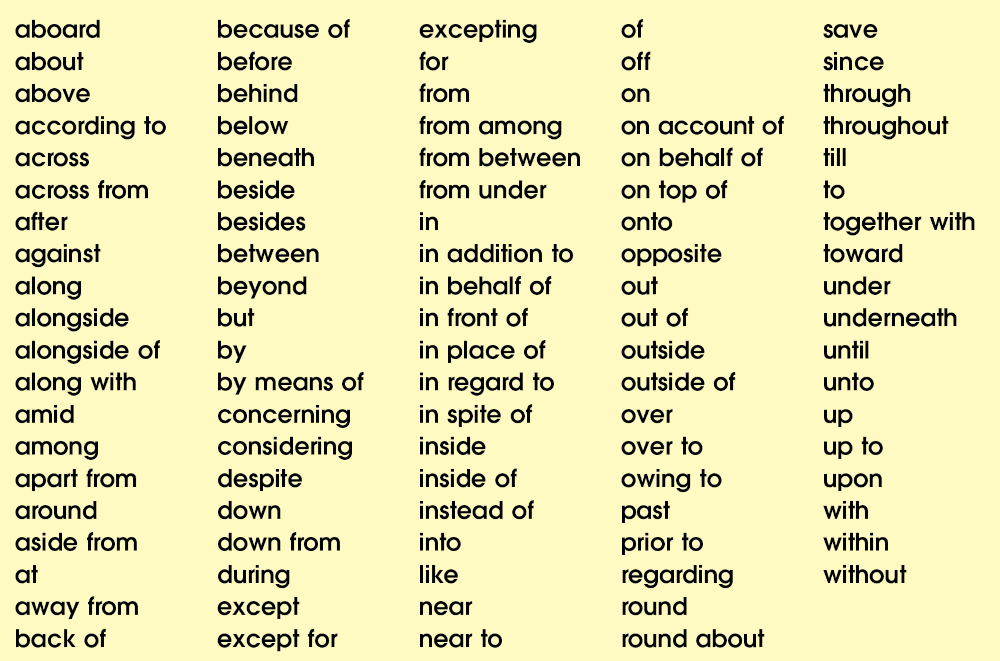
WOC 548
Page 548
Conjunction
A conjunction connects individual words or groups of words. There are three kinds of conjunctions: coordinating, correlative, and subordinating.
Polluted rivers and streams can be cleaned up.
(The conjunction and connects rivers and streams.)
548.1 Coordinating Conjunction
A coordinating conjunction connects a word to a word, a phrase to a phrase, or a clause to a clause. The words, phrases, or clauses joined by a coordinating conjunction must be equal.
To reduce pollution, you can plant a tree or ride a bike.
(Two equal phrases are connected by or.)
Planting trees adds oxygen to the atmosphere, and riding bikes helps to reduce greenhouse gas emissions.
(Two independent clauses are connected by and.)
Wearing a sweater and turning down the thermostat can conserve energy.
(Two equal phrases are connected by and.)
548.2 Correlative Conjunction
Correlative conjunctions are conjunctions used in pairs.
Either you’re part of the solution, or you’re part of the problem.
548.3 Subordinating Conjunction
A subordinating conjunction connects a dependent clause to an independent clause in order to complete the meaning of the dependent clause.
More people may get involved when they see Earth as “Home Sweet Home.”
(The clause when they see Earth as “Home Sweet Home” is dependent. It cannot stand alone.)
548.4 Conjunctions
Coordinating: and, but, or, nor, for, so, yet
Correlative: either, or; neither, nor; not only, but also; both, and; whether, or; as, so
Subordinating: after, although, as, as if, as long as, as though, because, before, if, in order that, provided that, since, so, so that, that, though, till, unless, until, when, where, whereas, while
Note: Conjunctive adverbs and relative pronouns can also connect clauses. (See 486.3 and 536.1.)
WOC 549
Page 549
Interjection
An interjection is a word or phrase used to express strong emotion or surprise. Punctuation (a comma or an exclamation point) is used to separate an interjection from the rest of the sentence.
Wow, would you look at that!
Oh no! He’s falling!
Whoops! So am I!
Parts of Speech Review
The chart below lists the eight parts of speech.
■ Noun A word that names a person, a place, a thing, or an idea
Alex Moya Belize ladder courage
■ Pronoun A word used in place of a noun
I he it they you anybody some
■ Verb A word that shows action or links a subject to another word in the sentence
sing shake catch is are
■ Adjective A word that describes a noun or a pronoun
stormy red rough seven grand
■ Adverb A word that describes a verb, an adjective, or another adverb
quickly today now bravely carefully
■ Preposition A word that often shows position or direction or introduces a prepositional phrase
around up under over between to
■ Conjunction A word that connects other words or groups of words
and but or so because when
■ Interjection A word (set off by a comma or an exclamation point) that shows strong emotion
Good grief! Hey, how are you?